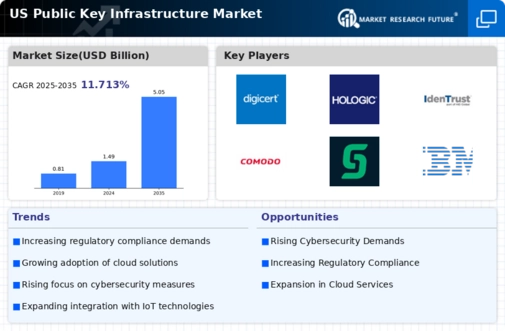Emergence of IoT Devices
The proliferation of Internet of Things (IoT) devices is creating new challenges and opportunities for the public key-infrastructure market. With billions of devices expected to be connected by 2025, the need for secure communication protocols is becoming increasingly critical. IoT devices often handle sensitive data, making them attractive targets for cybercriminals. Public key-infrastructure solutions are essential for authenticating devices and encrypting data transmitted between them. As industries such as manufacturing, healthcare, and smart cities embrace IoT technologies, the demand for public key-infrastructure to secure these networks is likely to grow, ensuring the safe operation of interconnected systems.
Increasing Cybersecurity Threats
The public key-infrastructure market is experiencing heightened demand due to the increasing frequency and sophistication of cyber threats. Organizations across various sectors are recognizing the necessity of robust security measures to protect sensitive data. In 2025, it is estimated that cybercrime will cost businesses globally over $10 trillion annually, prompting a shift towards advanced encryption technologies. This trend is particularly pronounced in the financial and healthcare sectors, where data breaches can lead to severe financial and reputational damage. As a result, investments in public key-infrastructure solutions are likely to surge, as companies seek to fortify their defenses against potential attacks.
Rising Adoption of Cloud Services
The shift towards cloud computing is significantly impacting the public key-infrastructure market. As organizations migrate their operations to the cloud, the need for secure data transmission and storage becomes paramount. In 2025, the cloud services market in the US is anticipated to exceed $500 billion, with a substantial portion of this growth driven by the demand for secure cloud solutions. Public key-infrastructure technologies are essential for ensuring data integrity and confidentiality in cloud environments. As businesses increasingly adopt hybrid and multi-cloud strategies, the reliance on public key-infrastructure for secure access and communication is likely to intensify.
Government Initiatives and Funding
Government initiatives aimed at enhancing national cybersecurity are significantly influencing the public key-infrastructure market. In recent years, federal agencies have allocated substantial funding to improve cybersecurity frameworks, with budgets exceeding $18 billion in 2025. This funding is directed towards developing secure communication channels and implementing encryption standards that align with public key-infrastructure protocols. Furthermore, the establishment of regulatory bodies to oversee cybersecurity practices is likely to drive demand for compliant solutions. As government mandates become more stringent, organizations will increasingly turn to public key-infrastructure technologies to meet these requirements and ensure the security of their operations.
Growth of E-commerce and Digital Transactions
The rapid expansion of e-commerce and digital transactions is a key driver for the public key-infrastructure market. As online shopping continues to gain traction, businesses are compelled to adopt secure payment systems to protect customer information. In 2025, e-commerce sales in the US are projected to reach $1 trillion, necessitating the implementation of robust encryption methods to safeguard transactions. Public key-infrastructure solutions play a crucial role in establishing trust between consumers and businesses, as they provide the necessary security for online communications. Consequently, the increasing reliance on digital platforms is expected to propel the demand for public key-infrastructure technologies.

























Leave a Comment